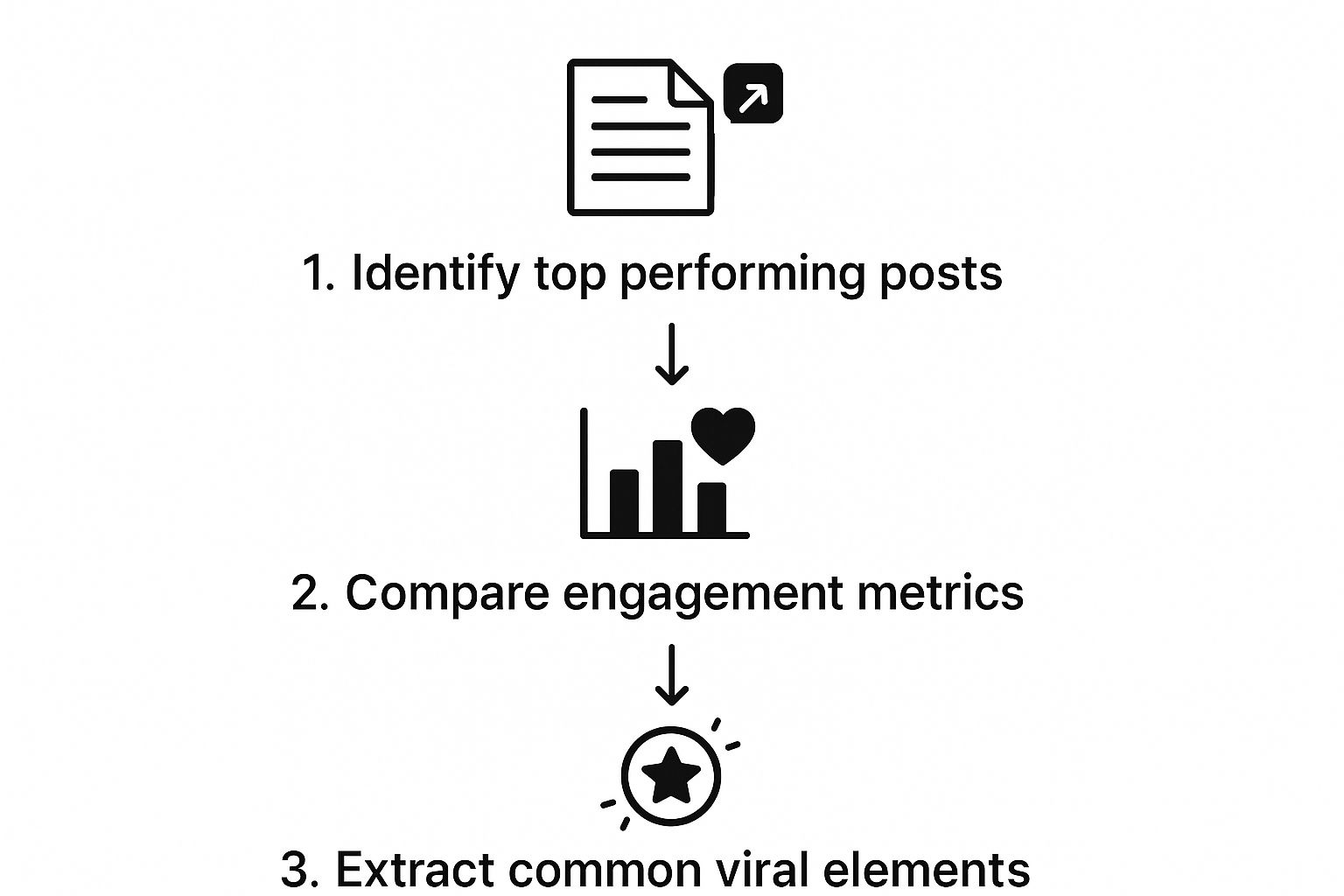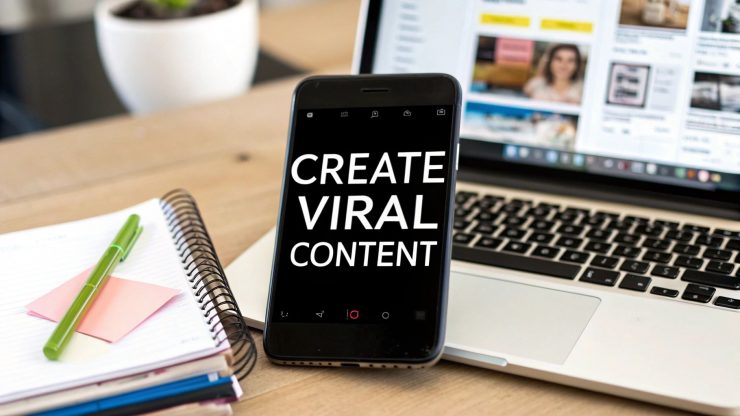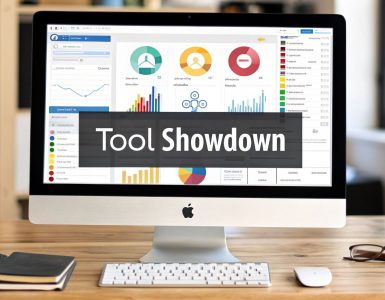Going viral isn't just a stroke of luck—it's about understanding what makes people tick. The real secret is crafting posts that tap into basic human motivations like emotion, identity, utility, or social currency.
Think about it: when a piece of content makes someone feel seen, smart, or genuinely helpful, they get an almost irresistible urge to pass it on.
What Makes People Hit 'Share'?
Before diving into the "how," we need to get a grip on the "why." People don't share stuff just because it looks good or is well-produced. They share it because it reflects something about them. At its heart, virality is more about psychology than production value.
Every single share is a little act of self-expression. Someone might share an uplifting video to be seen as a positive person, a deep-dive article to look intelligent, or a relatable meme to show off their sense of humor. Each time they share, they're building their personal brand among their friends and followers.
To get your content shared consistently, you need to build it on a solid foundation. These are the four pillars that support nearly every piece of viral content.
The Four Pillars of Viral Content
A solid understanding of these core drivers is essential for anyone serious about creating shareable content. Most viral hits nail at least one of these, and the truly massive ones often hit several at once.
| Pillar | Description | Example Tactic |
|---|---|---|
| Emotional Resonance | Does it spark a strong feeling? Awe, laughter, surprise, and even anger are powerful sharing triggers. | A heartwarming rescue story or a hilarious, relatable skit. |
| Social Currency | Does sharing this make someone look good? People love sharing things that make them seem smart or in the know. | An infographic with surprising industry stats or an early look at a new trend. |
| Practical Utility | Is it genuinely helpful? Actionable guides, life hacks, and practical tips provide immediate, real-world value. | A 30-second video showing how to properly peel a mango or a thread on a little-known keyboard shortcut. |
| Identity & Affiliation | Does it connect with someone's identity or community? Content that echoes a person's values or niche interests builds a powerful bond. | A post that starts with "Only true 90s kids will remember…" or content for a specific community like #BookTok. |
Mastering these pillars turns content creation from a guessing game into a strategic process. You're no longer just making things; you're engineering them to be shared.
The real magic happens when you combine these pillars. Imagine a video that’s emotionally powerful (emotion), teaches a unique skill (utility), and speaks directly to a specific subculture (identity). That’s the kind of content that becomes unstoppable.
This is where a tool like EvergreenFeed really shines. It helps you cut through the noise and see these patterns in action. By analyzing what’s already working, you can spot which psychological triggers are hitting home with your target audience.
Here’s a glimpse of how EvergreenFeed helps you get your content library in order, so you can spot these winning patterns yourself.

This kind of dashboard view lets you categorize everything you post. In no time, you'll see exactly which themes—whether it's your "helpful tips" or "inspirational quotes"—are actually getting the shares and driving growth.
Finding Your Next Viral Idea
The best creators I know don't just sit around waiting for a brilliant idea to pop into their heads. They've built something much more reliable: an idea engine. It's a system they've honed over time to consistently find out what people want to see, often before the audience even knows they want it.
Learning how to create viral content isn’t about being a random genius. It's about developing a repeatable process that starts with one simple act: listening. Instead of just throwing things at the wall to see what sticks, you need to dig into what's already grabbing people's attention.
Tapping into Existing Conversations
Your audience is constantly telling you what they love. You just have to know where to look and how to listen. This is where tools with robust content discovery features, like EvergreenFeed, become invaluable. You can set them up to monitor specific keywords, hashtags, or even your competitors' accounts to get a real-time feed of what's earning the most buzz.
Think of yourself as an anthropologist studying your niche. Your job is to observe, take notes, and figure out the themes, formats, and emotional triggers that consistently get results.
- Track Competitor Wins: What are they posting that gets a ton of shares and comments? Is it their behind-the-scenes stuff, their detailed how-to guides, or the relatable memes they share on Fridays?
- Monitor Niche Hashtags: Jump into the conversations happening around your industry. What are the burning questions people keep asking? What are their biggest frustrations?
- Identify Emerging Trends: See if you can spot a new format or topic before it gets completely saturated. Getting in early on a trend gives you a huge advantage.
This isn't about copying what they do. It’s about understanding why it works so you can apply those principles to your own unique content.
Building Your Personal Swipe File
As you're doing this research, don't just be a passive scroller. You need to actively collect the great stuff you see in a "swipe file." This is your personal, private library of proven concepts, amazing headlines, and eye-catching visuals. Any time a post makes you stop and think, "Damn, that's clever," save it.
A swipe file isn't for stealing ideas; it's for sparking them. It’s your evidence board of what’s connecting with people right now, giving you a solid launchpad for your own creativity.
This can be as simple as a folder on your computer, a private Pinterest board, or a tag in a note-taking app. I like to organize mine by type—hooks, calls-to-action, video formats, etc.—so I can quickly find inspiration when I'm stuck. It's a practice that has been fundamental to our own process of creating killer content for our blog.
Finding the Gaps Your Competitors Miss
Once you have a good handle on what everyone else is doing, you can start to see what they aren't doing. This is where the real opportunities lie. Analyzing successful content is just as much about finding the gaps—the unanswered questions and overlooked topics in your niche.
For example, maybe all your competitors are making super basic, 101-level guides. That's your cue to create an advanced tutorial for the more experienced crowd. Or if everyone's feed is serious and corporate, a little humor or a vulnerable personal story could be the thing that makes you stand out.
This is how you innovate. You take the proven ingredients from your swipe file and mix them with a fresh perspective that nobody else is offering.
The infographic below breaks down a simple way to deconstruct successful content to find your next winning idea.

Following a system like this helps you move past just imitating what's popular and into genuine innovation, all by understanding the core elements that make people click, comment, and share.
Sourcing Ideas from Your Own Community
Honestly, your most valuable source of ideas is right under your nose: your own audience. The comments, questions, and DMs you get every day are an absolute goldmine of authentic, ready-to-go content ideas.
- What's the one question people ask you over and over? Turn that into a definitive guide or a quick-tip video series.
- See an interesting debate happening in your comments section? Screenshot it (with permission) and create a whole new post around that discussion.
- Do people share how they're using your product or service? Showcase their stories and experiences.
Pulling ideas directly from your audience is a surefire way to create content that’s instantly relevant and valuable. It’s this genuine, creator-led approach that performs so well. There's a reason large companies now spend over $1.7 million a year on creator marketing—and why 74% of them say it delivers their highest ROI.
As you can read in these powerful social media statistics on Talkwalker.com, this success comes from creators making content that feels personal and relatable, which naturally encourages people to share it. By sourcing ideas from your community, you’re tapping into that very same power.
Creating Video Content People Can't Help But Share

Let's be honest. In the world of social media, video is king. Static images and clever copy have their place, but if you want something to truly catch fire and spread across the internet, video is your best bet. It’s the format that grabs attention, holds it, and makes people feel something.
The data backs this up completely. Projections show that video marketing is on pace to account for a staggering 82% of all internet traffic by 2025. On top of that, videos are 52% more likely to be shared than any other kind of content, making them the most powerful tool in your arsenal.
This is exactly why platforms like TikTok, Instagram Reels, and YouTube Shorts have exploded. They are built from the ground up for quick, captivating video moments that are designed to be passed around.
Hook Them in the First Three Seconds
You have about three seconds. That's it. In a world of infinite scrolling, there’s no time for a slow, cinematic opening. Your video has to immediately stop someone's thumb mid-scroll.
Think of those first few moments as your video's headline. It needs to pose a question, spark intense curiosity, or show something so visually interesting that they have to see what happens next. If you fail here, the rest of your brilliant content will never get seen.
Here are a few hook formulas I’ve seen work wonders:
- The Problem Hook: Start with a common frustration. "You're still peeling garlic this way? Stop." It's direct and promises a solution.
- The Curiosity Hook: Make a bold claim that demands an explanation. "This is the one thing all successful CEOs do before 8 AM."
- The Visual Hook: Show something mesmerizing or unexpected. It could be a perfect paint pour, a shocking before-and-after, or a breathtaking landscape.
Nailing the hook isn't just a suggestion; it’s the price of entry.
Tell a Complete Story in Under 60 Seconds
The videos that really stick with people, especially on short-form platforms, tell a complete and satisfying story. This doesn't mean you need a dramatic plot with twists and turns. It just needs a clear beginning, a middle, and a satisfying end.
This structure is what makes a video feel whole. It signals to the viewer that their time was well-spent and is a huge factor in getting them to watch all the way through—a critical metric for the algorithms.
The best short-form videos feel like a mini-movie. They introduce a concept, show the process or conflict, and deliver a payoff or resolution, all within 60 seconds. This narrative arc is what makes a video feel satisfying and shareable.
Take a simple recipe video, for instance. It starts with the ingredients (the beginning), shows the cooking process (the middle), and finishes with the plated, delicious-looking meal (the end). This straightforward arc is incredibly effective and can be adapted to almost anything, from a DIY project to a personal anecdote. To get better at this, it's worth exploring some effective video marketing strategies.
Design for Mobile, and Assume the Sound Is Off
The vast majority of people watching your video will be on their phone. This reality needs to shape every decision you make, right from the start.
So, what does that mean in practice?
- Shoot Vertically: Always, always shoot in a 9:16 aspect ratio. Horizontal video just feels clunky on a phone and forces people to turn their device, which most simply won't bother to do.
- Use Big, Bold Text: Any text on screen needs to be legible on a small display. Think high-contrast colors and fonts that are easy to read at a glance.
- Optimize for Muted Viewing: A huge chunk of your audience is scrolling in public places with their sound off. Your video has to make sense and still be engaging without a single note of audio. Use clear captions, descriptive visuals, and on-screen text to guide them through the story.
This isn't to say sound doesn't matter. For the viewers who do have their audio on, it can be a game-changer.
Tap Into Trending Audio and Music
On platforms like TikTok and Instagram, trending audio is one of the most powerful discovery engines you have at your disposal. Using a popular sound is like giving the algorithm a giant hint to show your video to a wider audience that’s already proven to like that particular audio clip.
Think of trending sounds as a shortcut to relevance. They provide a familiar framework for you to put your own unique spin on. The real magic happens when you adapt a trend to your specific niche in a creative way, rather than just copying what you've seen others do.
Make it a habit to scroll through your "For You" page or browse the audio library in the apps to see what's picking up steam. Hopping on a sound early can give your content a massive boost in reach.
Turn Your Viewers into Participants
Finally, the most viral content does one thing exceptionally well: it invites people to join in. It doesn't just broadcast a message; it creates an opportunity for the viewer to become part of the experience.
This shift from passive consumption to active participation is what drives comments, shares, and follows through the roof.
Here are a few ways to get your audience involved:
- Ask a Question: End your video by asking your audience something directly. "What's the one travel hack you can't live without? Let me know below!" It’s a simple call to action that gets the conversation started.
- Create a Duet or Stitch Opportunity: On TikTok, create content that's practically begging to be remixed. This could be an open-ended statement, a challenge, or a clip that others can easily react to.
- Launch a Challenge: Come up with a simple, fun challenge and give it a unique hashtag. Encourage your followers to make their own versions and tag you.
When you make your audience a co-creator, you’re not just chasing views. You’re building a community. And that is the true engine for creating content that consistently goes viral.
Optimizing Content for Maximum Reach

A fantastic idea is a great start, but it's only half the battle. The real magic in going viral is making sure that brilliant idea actually gets seen by the people who will love and share it. This is where you have to shift your thinking from just being a creator to being a strategist.
Every single part of your post—from the headline and hashtags to the exact time you publish—is a lever you can pull to boost its potential. If you skip this optimization step, even the most amazing content can get lost in the noise.
Writing Headlines and Captions That Earn Clicks
Let's be honest, the first thing anyone sees is your headline or caption. This small bit of text has a huge job: it has to make someone stop their endless scrolling and pay attention.
A great headline doesn't just describe your content; it sparks curiosity. It might make a bold promise, ask a challenging question, or hint at a solution to a problem your audience is wrestling with. Think of it as the movie trailer for your content—it needs to be compelling on its own.
We've gone deep on this topic before. For a full masterclass, check out our guide on how to write perfect headlines for your blog posts. The core principles are the same whether you're writing for a long article or a 15-second video.
The Art of Strategic Hashtagging
I see it all the time: people just slap a bunch of hashtags on a post at the last minute. This is a huge mistake. Hashtags are your content's GPS, guiding new audiences directly to you on platforms like Instagram, TikTok, and X.
The secret is to use a strategic mix.
- Broad, high-volume tags: These are your
#marketingor#contentcreationtypes. They offer massive reach but come with equally massive competition. - Niche, community tags: Getting more specific with something like
#socialmediamanagerslifeconnects you with a dedicated group that’s much more likely to engage. - Trending tags: Jumping on a relevant, timely conversation can give your content a quick visibility boost.
Forget stuffing your post with 30 generic tags. A carefully chosen list of 5-10 highly relevant hashtags that perfectly match your content and target audience will always perform better. Quality over quantity is the rule here.
Think of hashtags as signposts. You wouldn't put a sign for a coffee shop on a highway leading to a hardware store. Your hashtags need to guide the right people directly to your content.
Tailoring Your Content for Each Platform
Posting the exact same content across all your social profiles is one of the fastest routes to mediocre results. Every platform has its own algorithm, its own culture, and its own user expectations. What kills it on LinkedIn will almost certainly die on TikTok.
For example, LinkedIn is all about professional insights and longer text posts. Instagram, on the other hand, is a visual-first world where stunning images and quick, punchy Reels are king. And TikTok's algorithm is a different beast entirely, favoring content that cleverly uses trending audio and popular video formats.
To give your content the best shot, you have to adapt it. That could mean writing totally different captions, re-editing a video for a vertical screen, or pulling a powerful quote to create a standalone graphic. Yes, it's more work, but it's what separates the content that blends in from the content that stands out.
This is where a tool like EvergreenFeed becomes your secret weapon. It helps you pinpoint the absolute best times to post for each unique account and audience. When you schedule your perfectly tailored content to go live right when your followers are most active, you feed the algorithm the early engagement it needs to start showing your post to a much wider audience. That's how you give great content a real chance to take off.
Using Partnerships to Amplify Your Content
You can create the most incredible piece of content in the world, but sometimes it still needs a little nudge to really take off. That’s where smart partnerships come into play. Collaborating with the right creators can put your work in front of thousands of new, genuinely interested people, essentially pouring gasoline on your viral fire.
Forget the old days of just paying for a generic shoutout. Audiences today are sharp—they can sniff out an inauthentic promotion from a mile away. The real secret is building genuine relationships with creators whose followers are a perfect match for your brand and what you have to say.
Finding the Right Partners
The biggest mistake I see brands make is getting obsessed with follower counts. A creator with 10,000 highly engaged, niche followers is way more valuable than one with 100,000 who barely pay attention. You’re after resonance, not just raw numbers.
Start by looking for creators who are already a part of the conversations you want to join.
- Watch for real engagement: Is their comments section buzzing with actual discussion? That's a huge sign of a healthy, trusting community.
- Check out their audience: Do their followers look like your ideal customer? A quick scroll through who’s commenting and liking their posts will give you a pretty good idea.
- Make sure your brands align: Does their style and tone feel like a natural fit for yours? A good collaboration should feel like a seamless match, not a forced ad.
Once you’ve got a shortlist, the next step is to build a real connection. Like their stuff, share their work, and offer them something of value long before you ever ask for anything. By the way, this same approach works wonders when you're trying to get new customers using Twitter.
Crafting a Winning Outreach
Creators get bombarded with generic, copy-pasted DMs every single day. If you want to stand out, your message has to be personal, specific, and all about what’s in it for them. Show them you’ve actually paid attention.
Mention a specific video or post of theirs you genuinely enjoyed. Explain exactly why you think working together would be awesome for their audience, not just a win for you. This simple act of showing respect for their craft immediately separates you from the noise.
A great partnership isn't a transaction; it's a co-creation. The goal should be to make something together that neither of you could have made alone—content that provides genuine value to the creator's community.
This focus on authentic collaboration is exactly what's fueling the creator economy’s massive growth. What was a $1.4 billion market back in 2014 is on track to become a $32.55 billion industry by 2025. You can dig into more of these insights in the latest report from Influencer Marketing Hub, which shows how these partnerships have become one of the most reliable paths to going viral.
Negotiating a Mutual Win
Once you've made contact, don't just think about a single post. Could you co-create a video series? Maybe host a joint livestream or have them contribute a guest post to your blog? The partnerships that really hit home are built on a foundation of shared value.
Be upfront about what they get out of it, whether that's cash, exposure to your audience, or free access to your product. A successful collaboration makes everyone look good and strengthens the bond they have with their followers. When you get that right, you don't just get a one-off promotion; you get a powerful endorsement from a voice people trust, and that can kickstart a sharing frenzy.
Let's Put This All Together
So, we've unpacked the science behind what makes content go viral. It's not about catching lightning in a bottle; it's about building a repeatable system. We've gone through everything from the psychology of sharing to the nitty-gritty of making videos that people can't ignore. The big idea here is that every single step, from the first spark of an idea to how you push it out into the world, matters.
The pillars of a successful viral strategy are pretty straightforward. You have to stop guessing and start building your content on solid data. That means getting inside your audience's head, figuring out what makes them tick, and then consistently delivering content that hits those emotional buttons. It’s a deliberate cycle: create, fine-tune, and then get it in front of the right people.
Your Playbook for Going Viral, Again and Again
Let's boil this down to a clear, repeatable process you can start using right now.
- Start with Why: First and foremost, you have to understand the core psychological triggers. Why do people share? It usually comes down to utility (is it helpful?), identity (does it reflect who they are?), and social currency (does it make them look good?).
- Let Data Guide Your Ideas: Don't just brainstorm in a vacuum. Use a tool like EvergreenFeed to see what's already crushing it in your niche. You can spot emerging trends and find those content gaps your competitors haven't noticed yet.
- Build a Better Video: You have three seconds. That's it. You need a killer hook, a story that resolves quickly, and a video that makes sense even with the sound off. Always think mobile-first.
- Optimize for Maximum Reach: Your content needs the right packaging. This means writing headlines that are impossible to ignore, using a smart mix of popular and niche hashtags, and tweaking every post to fit the platform it’s on. What works on TikTok won't necessarily fly on LinkedIn.
- Partner Up to Amplify: The fastest way to kickstart the sharing process is to team up with creators who already have your target audience's trust. Their endorsement can be the spark that lights the fire.
The real goal isn't just one viral hit. It’s about creating a steady flow of content that resonates, builds a dedicated following, and keeps your brand top of mind. Think of it as a marathon of great content, not a sprint for a single trophy.
This whole process starts with your very next post. Begin testing these ideas, dig into your analytics to see what’s moving the needle, and keep tweaking your approach. The data will tell you what’s working. Once you get into this rhythm of testing and learning, you'll find that going viral feels less like winning the lottery and more like a predictable outcome of a well-executed plan.
Got Questions? We’ve Got Answers.
Jumping into the world of viral content can feel like navigating a maze. It’s one part smart strategy, one part lightning in a bottle. Let's tackle some of the most common questions that pop up when you're just getting started.
How Long Until I Actually See Results?
This is the big one, isn't it? The honest-to-goodness answer is, it’s all over the map. There's no on/off switch for virality. I’ve seen content explode within hours, while other brilliant pieces take weeks to slowly build steam and catch fire.
The key is to adjust your expectations. Instead of holding your breath for that one massive viral hit, look for steady progress. You should start seeing positive signs within the first few months. Are your engagement rates ticking up? Are people sharing your posts more often? Those are the real signals that your strategy is starting to pay off.
Do I Need a Huge Budget to Go Viral?
Not at all. Seriously. Some of the most iconic viral content was made on a shoestring budget, or no budget at all. What makes something shareable isn't a glossy production—it’s a powerful idea that connects with people on an emotional level. A clever, funny video shot on an iPhone can run circles around a polished but soulless corporate ad.
Put your energy where it counts:
- Great Ideas: Spend your time digging into what your audience really cares about and brainstorming concepts that will stick with them.
- Real Authenticity: People connect with genuine, relatable content. That’s free, and it’s priceless.
- Smart Sharing: Getting your content in front of the right communities is way more effective than just throwing money at ads.
Your creativity and grasp of what makes people tick are your most valuable assets here, not a fat wallet.
The most crucial investment is time—time spent researching what resonates, engaging with your community, and refining your unique voice. That's what separates memorable content from expensive but forgettable noise.
What are the Biggest Mistakes People Make?
I see creators fall into the same traps over and over. If you can sidestep these, you’re already way ahead of the game. The absolute biggest mistake is trying to be everything to everyone. When you create content for the masses, it usually ends up feeling so generic that it connects with no one.
Chasing trends at the expense of your own voice is another classic blunder. Sure, hopping on a trend might give you a quick bump, but if it feels forced or off-brand, your audience will sniff it out immediately. And finally, don't just post and pray. Creating something amazing is only half the job. Without a solid plan to get it out there, even the best content will just sit there, unseen.
Ready to stop guessing and start building a reliable system for your social media? EvergreenFeed automates your content scheduling, so you can focus on creating the next viral hit. Start automating your content for free today.




